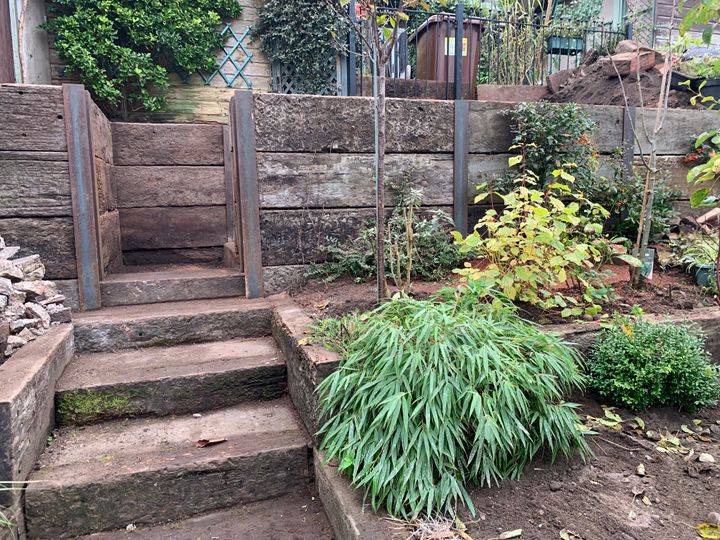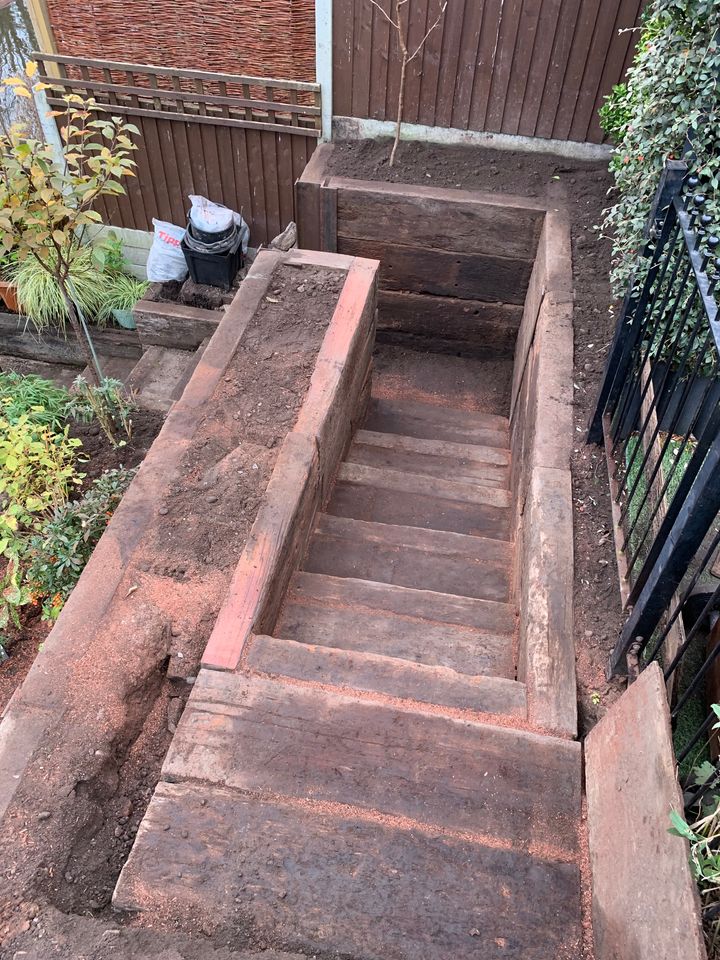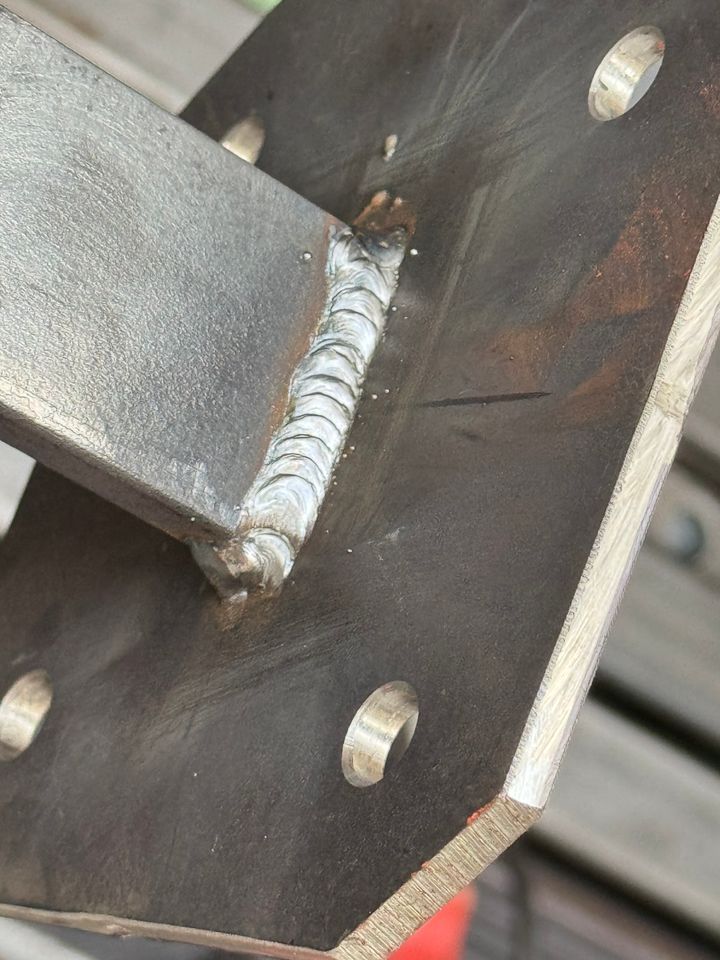Welding thick steel with a hobby MIG
Discussion
Question for the welding experts….
I’m going to be making some estate fencing for my garden, using ‘kit’ materials (pre cut mild steel)
The posts will be bolted into hardwood sleepers (proper tropical hardwood, actual sleepers, not fake tanalised stuff). To do this, I need to weld a 150mm square mounting plate to the bottom of the posts. Post and plate are 8mm thick mild steel. Once assembled, the bars will also be welded into the posts, but these joints will never be subjected to the same forces as the baseplates.
My welder is an old, but reliable Clarke 110EN MIG (choice of gas or no gas). Max output is 100amps.
Clearly, there’s no way it will achieve amazing penetration on a single pass, but I’m hoping that some beveling of the post where it meets the baseplate, and some pre-heating will be enough to get a decent weld with (probably) three passes around the full circumference of the post.
Whilst man-maths is pointing me towards a new welder, it would be wasteful and not much more powerful than what I already have (it’ll be running off normal household 240v single phase). This will probably be the first and last time I’ll ever work on 8mm material.
I’ve read that going gasless with flux wire can get better penetration that with gas, but I’m not 100% sure
Any help or suggestions gratefully received…
I’m going to be making some estate fencing for my garden, using ‘kit’ materials (pre cut mild steel)
The posts will be bolted into hardwood sleepers (proper tropical hardwood, actual sleepers, not fake tanalised stuff). To do this, I need to weld a 150mm square mounting plate to the bottom of the posts. Post and plate are 8mm thick mild steel. Once assembled, the bars will also be welded into the posts, but these joints will never be subjected to the same forces as the baseplates.
My welder is an old, but reliable Clarke 110EN MIG (choice of gas or no gas). Max output is 100amps.
Clearly, there’s no way it will achieve amazing penetration on a single pass, but I’m hoping that some beveling of the post where it meets the baseplate, and some pre-heating will be enough to get a decent weld with (probably) three passes around the full circumference of the post.
Whilst man-maths is pointing me towards a new welder, it would be wasteful and not much more powerful than what I already have (it’ll be running off normal household 240v single phase). This will probably be the first and last time I’ll ever work on 8mm material.
I’ve read that going gasless with flux wire can get better penetration that with gas, but I’m not 100% sure
Any help or suggestions gratefully received…
There’s no way I’ll get everything done in a day or two, so hiring isn’t worth considering. Buying a stick welder isn’t really on the cards. If I can’t get a strong weld, I’ll do what’s suggested above and tack the plates in place and get a local fab shop to do it properly
The sleepers are stacked on edge, four deep, set into really chunky H-section steels, so they aren’t going anywhere. I’ll be using 120mm M10 stainless coach bolts, into pilot holes, so they will be very secure. There really isn’t enough soil to secure the posts, and in any event, I want the fencing along the top of the sleepers - should prevent grandchildren and dogs falling off the edge….


From everything I’ve read in t’internet and watched on YouTube, as long as I weld all the way round the post, it should be difficult to break by pushing at it.
I’ve just had a quick go with a blowtorch and I got the steel to well over 200 degrees, so that should help too…
The sleepers are stacked on edge, four deep, set into really chunky H-section steels, so they aren’t going anywhere. I’ll be using 120mm M10 stainless coach bolts, into pilot holes, so they will be very secure. There really isn’t enough soil to secure the posts, and in any event, I want the fencing along the top of the sleepers - should prevent grandchildren and dogs falling off the edge….
From everything I’ve read in t’internet and watched on YouTube, as long as I weld all the way round the post, it should be difficult to break by pushing at it.
I’ve just had a quick go with a blowtorch and I got the steel to well over 200 degrees, so that should help too…
Well - that seems to have gone OK…
I beveled the end of the upright, and pre-heated the upright and baseplate to about 200 degrees before welding.
I don’t suppose I’ve got amazing penetration and if it was safety-critical, I would have got a pro to do it. However, I’ve given it some serious grief with a lump hammer at all sorts of angles and it hasn’t budged, so I’m calling it a success

I beveled the end of the upright, and pre-heated the upright and baseplate to about 200 degrees before welding.
I don’t suppose I’ve got amazing penetration and if it was safety-critical, I would have got a pro to do it. However, I’ve given it some serious grief with a lump hammer at all sorts of angles and it hasn’t budged, so I’m calling it a success
Nigel_O said:
Well - that seems to have gone OK…
I beveled the end of the upright, and pre-heated the upright and baseplate to about 200 degrees before welding.
I don’t suppose I’ve got amazing penetration and if it was safety-critical, I would have got a pro to do it. However, I’ve given it some serious grief with a lump hammer at all sorts of angles and it hasn’t budged, so I’m calling it a success

I don’t know what you were worried about , I’ve seen people charge money for that , in fact I’ve seen people charge money for nowhere near as good as that , well done . I beveled the end of the upright, and pre-heated the upright and baseplate to about 200 degrees before welding.
I don’t suppose I’ve got amazing penetration and if it was safety-critical, I would have got a pro to do it. However, I’ve given it some serious grief with a lump hammer at all sorts of angles and it hasn’t budged, so I’m calling it a success
Nigel_O said:
Well - that seems to have gone OK…
I beveled the end of the upright, and pre-heated the upright and baseplate to about 200 degrees before welding.
I don’t suppose I’ve got amazing penetration and if it was safety-critical, I would have got a pro to do it. However, I’ve given it some serious grief with a lump hammer at all sorts of angles and it hasn’t budged, so I’m calling it a success

I'm no welder by any stretch of the imagination but I've met a couple of very good welders over the years and the bit in bold is the secret to quality welds.I beveled the end of the upright, and pre-heated the upright and baseplate to about 200 degrees before welding.
I don’t suppose I’ve got amazing penetration and if it was safety-critical, I would have got a pro to do it. However, I’ve given it some serious grief with a lump hammer at all sorts of angles and it hasn’t budged, so I’m calling it a success
It's tricky to explain but by pre-heating the parts you're stopping them from pulling the heat out of the actual weld as you're welding so you get better penetration (Oooer Missus!!) and a stronger weld.
Gassing Station | Homes, Gardens and DIY | Top of Page | What's New | My Stuff



